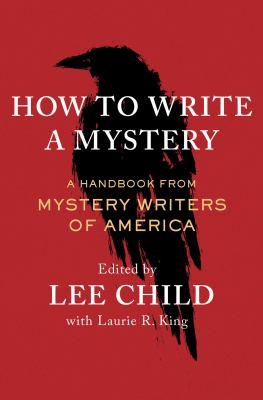
How to write a mystery : a handbook from Mystery Writers of America
From the most successful mystery writers in the business, an invaluable guide to crafting mysteries--from character development and plot to procedurals and thrillers--a must-have for every aspiring mystery writer.
Available Copies by Location
| Location | |
|---|---|
| Stamford | Available |
Browse Related Items
| Subject |
| Detective and mystery stories > Authorship. Authorship. |
| Genre |
| Literature. |
- ISBN: 9781982149437
- Physical Description ix, 326 pages ; 24 cm
- Edition First Scribner hardcover edition.
- Publisher [Place of publication not identified] : [publisher not identified], 2021.
Content descriptions
| General Note: | Includes index. |
Additional Information

Kirkus Review
How to Write a Mystery : A Handbook from Mystery Writers of America
Kirkus Reviews
Copyright (c) Kirkus Reviews, used with permission.
Everything you wanted to know about how to plan, draft, write, revise, publish, and market a mystery, courtesy of the cheerleaders from the Mystery Writers of America. In a marketplace crowded with how-to-write titles, the big selling point of this one is the variety of voices behind more than 30 full-length chapters covering everything from mystery subgenres (Neil Nyren) to publishing law (Daniel Stevens), punctuated with a variety of shorter interpolations. A few of them are more pointed than the longer chapters--e.g., when Rob Hart advises, "Allow yourself the space to forget things," Tim Maleeny says, "Love your characters, but treat them like dirt," or C.M. Surrisi notes, "If you're writing a mystery for kids, remember that your protagonist can't drive and has a curfew, and no one will believe them or let them be involved." The contributors vary in their approaches, from businesslike (Dale W. Berry and Gary Phillips on the process of creating graphic novels, Liliana Hart on self-publishing, Maddee James on cultivating an online presence) to personal (Frankie Y. Bailey on creating diverse characters, Chris Grabenstein on writing for middle schoolers, Catriona McPherson on deploying humor) to autobiographical (Rachel Howzell Hall on creating a Black female detective, Louise Penny on building a community of followers) to frankly self-promoting (T. Jefferson Parker on creating villains, Max Allan Collins on continuing someone else's franchise). Although many familiar bromides are recycled--"All stories are character-driven," writes Allison Brennan, and Jacqueline Winspear, Gayle Lynds, and Daniel Stashower all urge the paramount importance of research--the most entertaining moments are the inevitable disagreements that crop up, especially between Jeffery Deaver ("Always Outline!") and editor Child ("Never Outline!"), with Deaver getting the better of the argument. Other contributors include Alex Segura, William Kent Krueger, Tess Gerritsen, and Hallie Ephron. A chorus of encouraging voices that mix do-this instruction with companionable inspiration. Copyright (c) Kirkus Reviews, used with permission.

Publishers Weekly Review
How to Write a Mystery : A Handbook from Mystery Writers of America
Publishers Weekly
(c) Copyright PWxyz, LLC. All rights reserved
More is less in this uneven anthology for the aspiring mystery writer, edited by Child (the Jack Reacher series) and featuring contributions from over 50 authors. "Mystery writers," Child writes, "is a noble and evocative term, but we shouldn't think it limits us," and the entries that follow are a mixed bag of quick hits and worthy advice. Marilyn Stasio's "How Not to Get Reviewed," for example, is a single sentence offering: "Send multiple copies of your book to the reviewer's home and keep bugging her by email." Louise Penny's "Building Your Community," on the other hand, is a standout. In it, she recounts how she built an audience by opening up to her fans, prompted by advice to promote herself because if readers "like you, they'll probably buy your book, and will probably like it." Jeffery Deaver's "Always Outline" urges against "pansters" who "write by the seat of their pants," while Child follows with a plea to "Never Outline." The most valuable insights come on the craft level: Jacqueline Winspear's tips on setting mysteries in the past and Catriona McPherson's on incorporating humor, for example, hit as practical and insightful. Budding authors looking for pro tips will find some useful tidbits, but this is ground mostly covered. (Apr.)

BookList Review
How to Write a Mystery : A Handbook from Mystery Writers of America
Booklist
From Booklist, Copyright (c) American Library Association. Used with permission.
Featuring a powerhouse list of contributors (Jeffery Deaver, Linwood Barclay, Lee Child, Deborah Crombie, Meg Gardiner, Charlaine Harris, T. Jefferson Parker, and many more), this collection of essays from Mystery Writers of America offers a comprehensive and highly informative guide to writing crime fiction. The contributors discuss amateur sleuthing, the mechanics of the thriller, the differences between noir and hard-boiled detective stories, historical mysteries, true crime, graphic novels, YA stories, medical thrillers, the spy novel, and even novelizations. Recurring themes: doing the necessary research, getting the small details right, and creating characters with depth and a real human presence. It's just a wonderful book, a seminar in genre writing conducted by some of the genre's most accomplished practitioners. Especially interesting are the varying points of view on some subjects (Deaver says outlining is essential; Child says never mind the outline); readers soon learn that there is no one right way to go about writing crime fiction, and that the goal should be to find the process that works best for them. This is a writing guide that readers and writers will turn to again and again.


